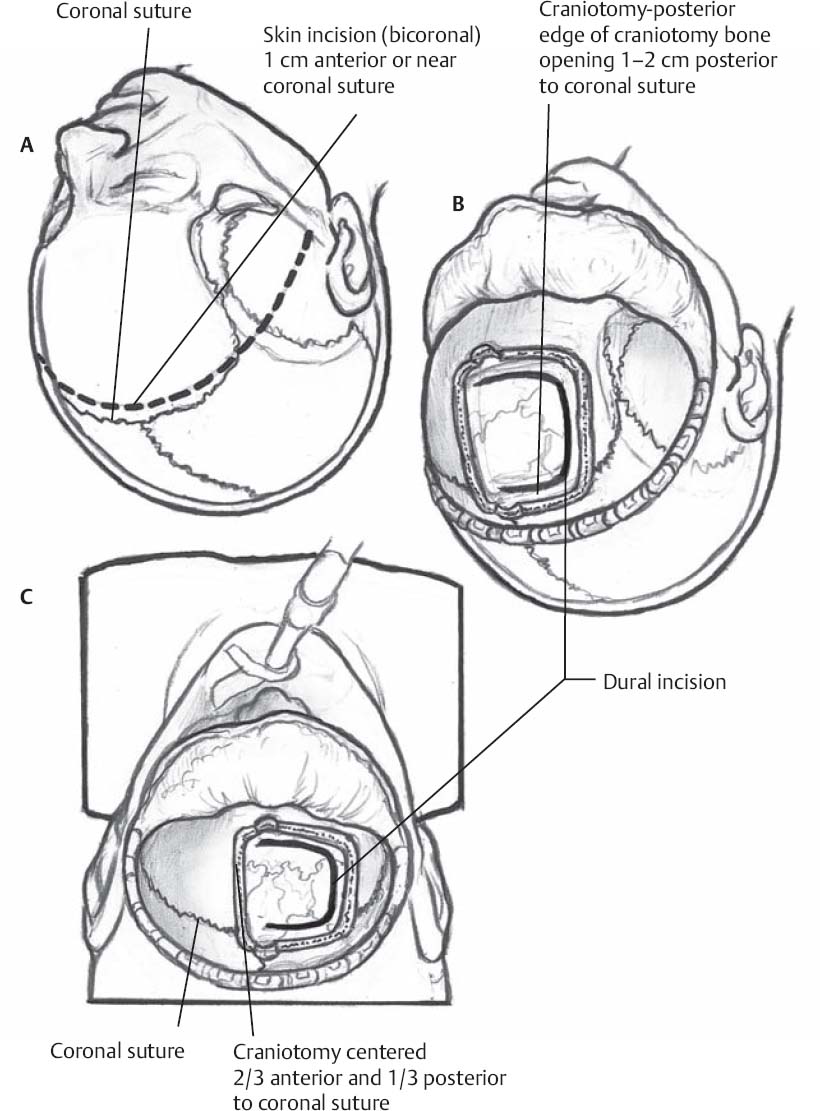♦ Intraoperative
Positioning
- Mayfield skull pin sites are placed behind hairline
- For convexity lesions, flex or extend neck and turn head so that craniotomy flap is as parallel to floor as possible, with the operative site as the highest point on the field
- For anterior interhemispheric approach, head may be neutral or lateral with lesion side down
- Head position should allow gravity to facilitate brain retraction
- Neck should be positioned to avoid excessive compression of jugular veins and the endotracheal tube
- Head of bed elevation and ipsilateral shoulder elevation with a roll (if the head is turned) are used to ensure adequate jugular venous return
Incision and Scalp Flap
- Unilateral approach
- Linear or curvilinear incisions are suitable for small lesions requiring unilateral craniotomies located behind the hairline
- Bicoronal incision extending from 1 cm anterior to the ipsilateral tragus to the contralateral side (may terminate at 1 cm anterior to contralateral tragus for a true bicoronal incision, or at the contralateral superior temporal line for a modified bicoronal incision; Fig. 4.1A) is used for craniotomies anterior to the hairline
- Linear or curvilinear incisions are suitable for small lesions requiring unilateral craniotomies located behind the hairline
- Bilateral approach
- True bicoronal incision permits access to floor of frontal fossa
- Avoid damage to superficial temporal artery to preserve vascular supply to scalp
- True bicoronal incision permits access to floor of frontal fossa
- Temporalis fascia and muscle are preserved unless lateral edge of bone flap is planned to extend inferior to superior temporal line and requires subperiosteal dissection of temporalis muscle
- Self retaining retractors or fishhooks are used for anterior retraction of scalp flap, which is protected with wet sponge to preserve pericranium for possible graft and to prevent pressure necrosis on forehead
Burr Holes
- Unilateral approach
- For most frontal craniotomies, a single burr hole created with a round burr or perforator drill bit may be used to start unilateral craniotomy
< div class='tao-gold-member'>
Fig. 4.1 (A) Modified bicoronal skin incision allows frontal craniotomy to cross the midline. Burr holes spanning across the superior sagittal sinus are created at the anterior and posterior edges of the bone flap (B). For an anterior interhemispheric approach, two thirds of the craniotomy is anterior and one third of the craniotomy is posterior to the coronal suture (C).
Only gold members can continue reading. Log In or Register to continue
Stay updated, free articles. Join our Telegram channel
- For most frontal craniotomies, a single burr hole created with a round burr or perforator drill bit may be used to start unilateral craniotomy

Full access? Get Clinical Tree







